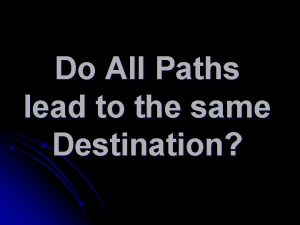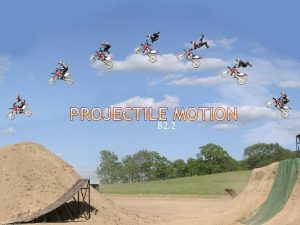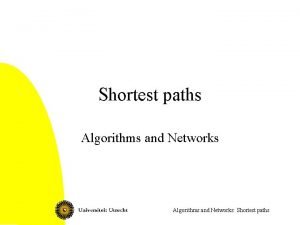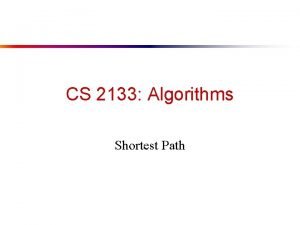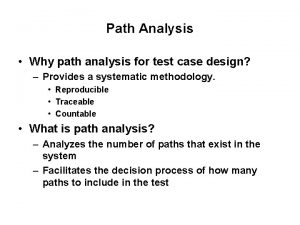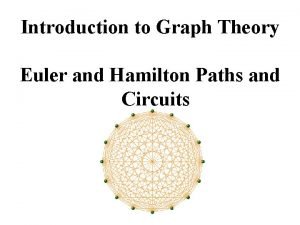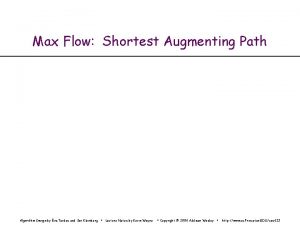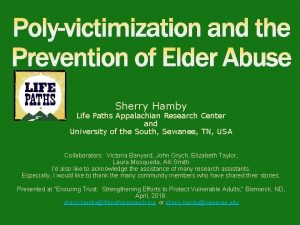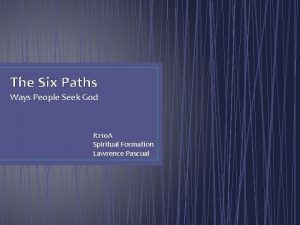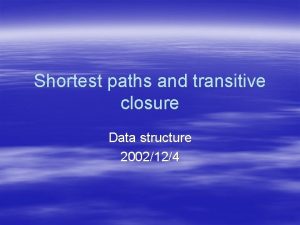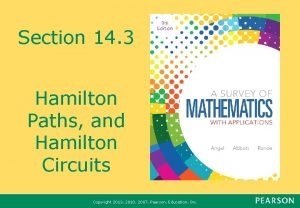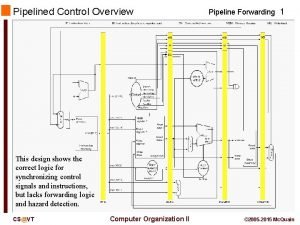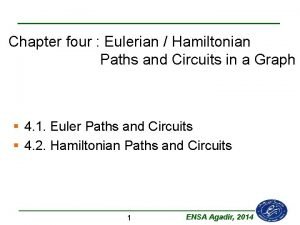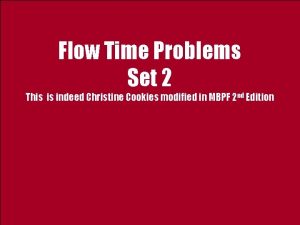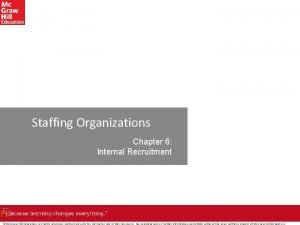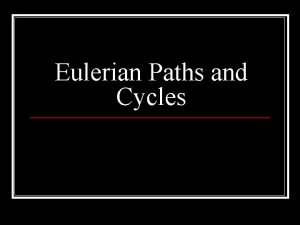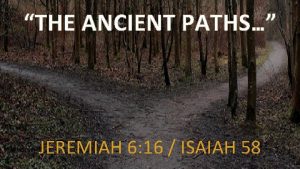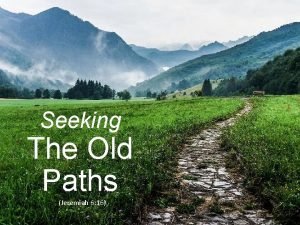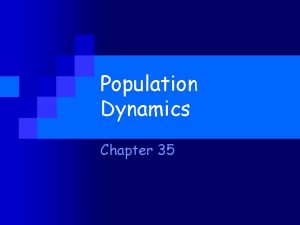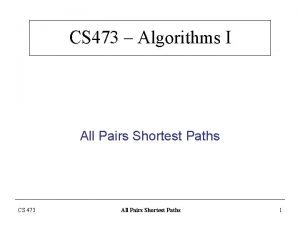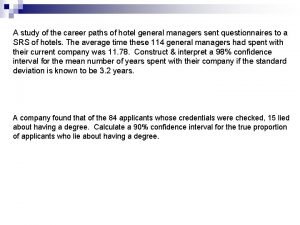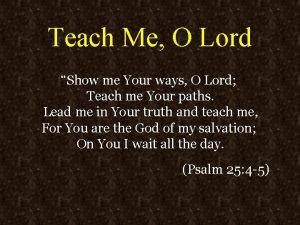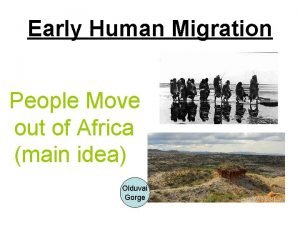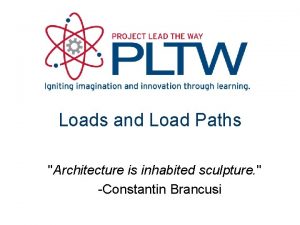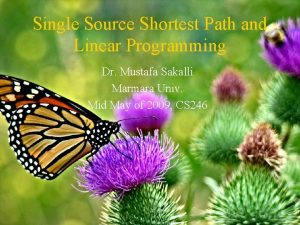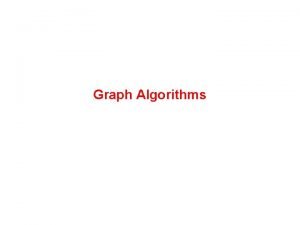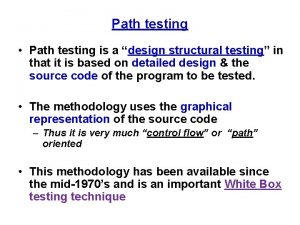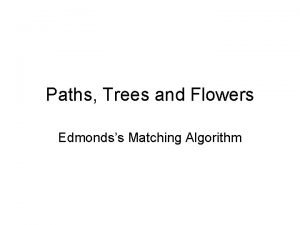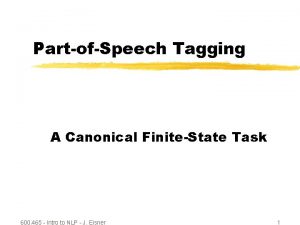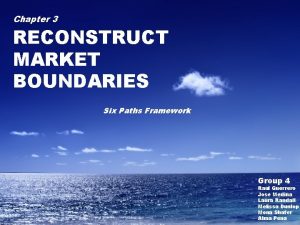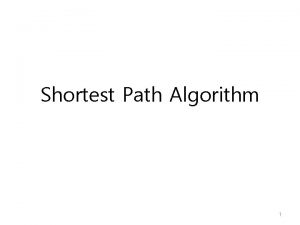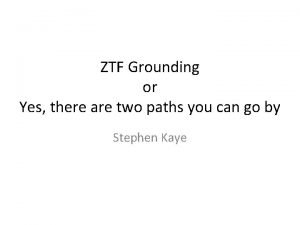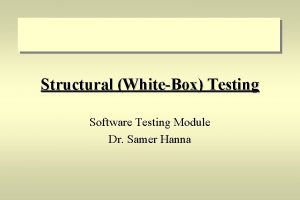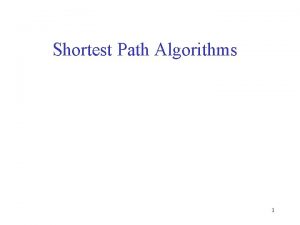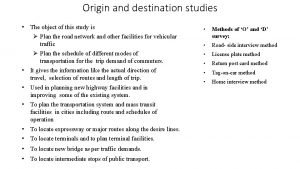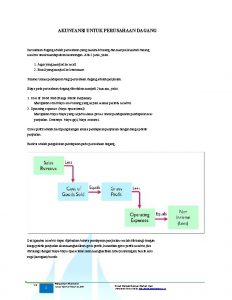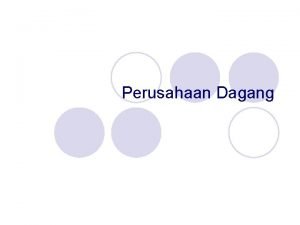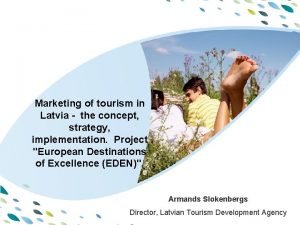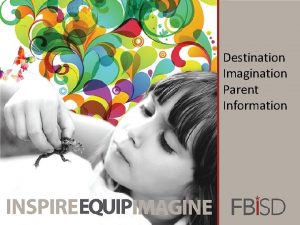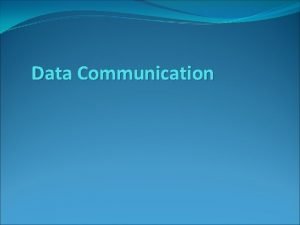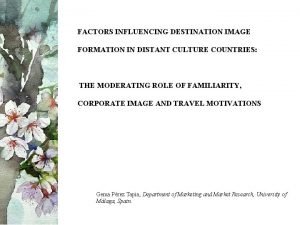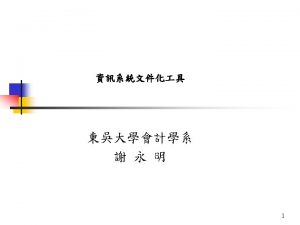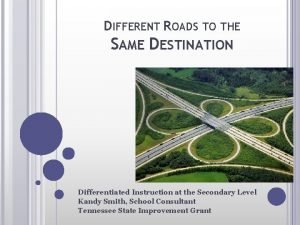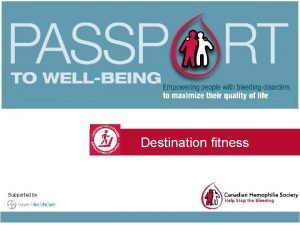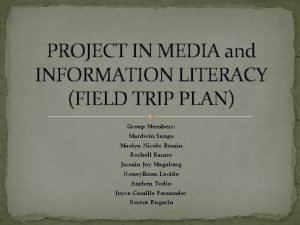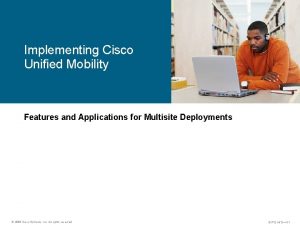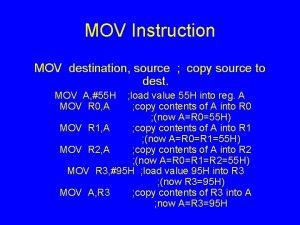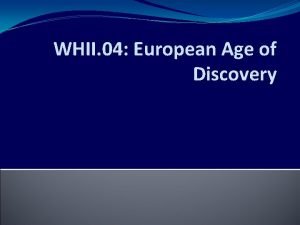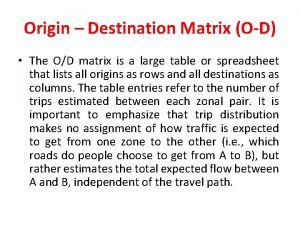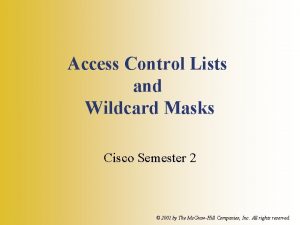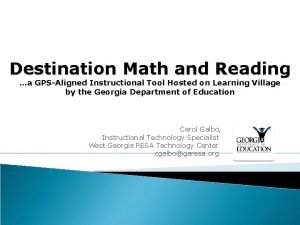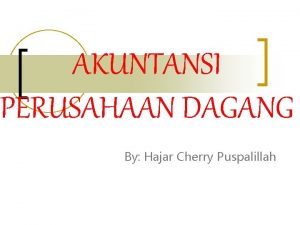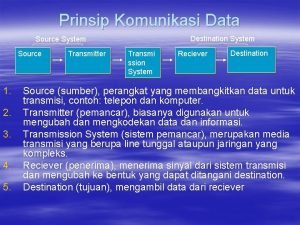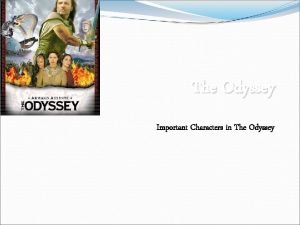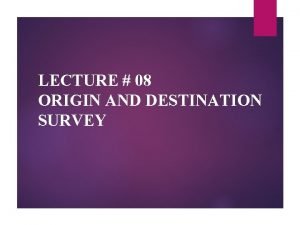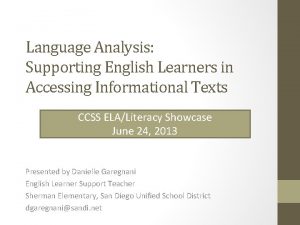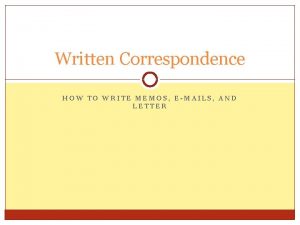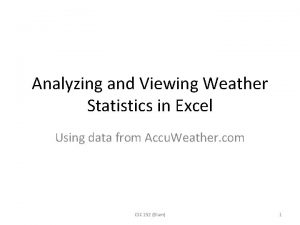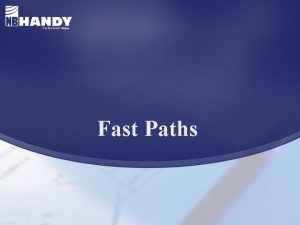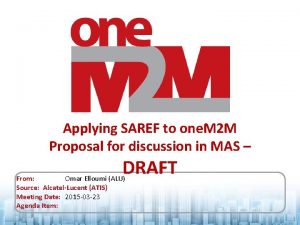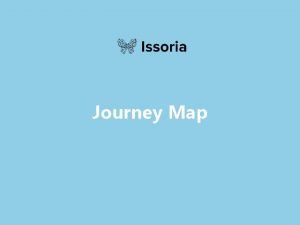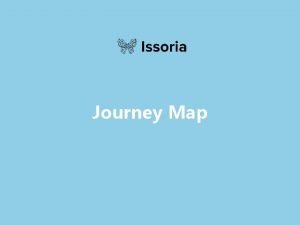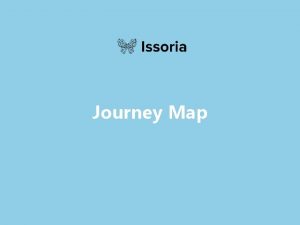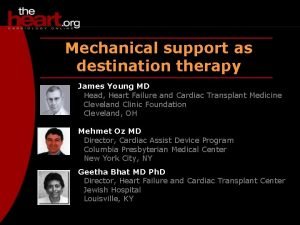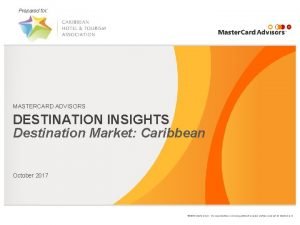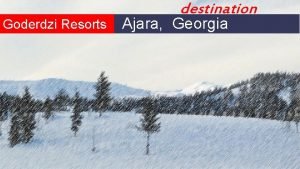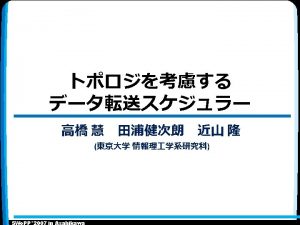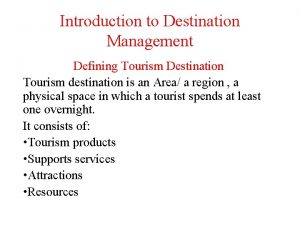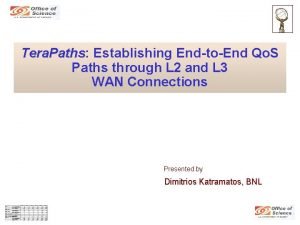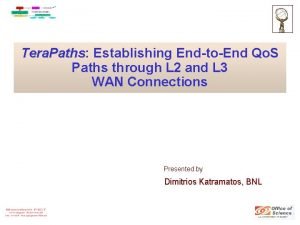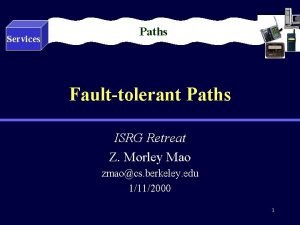Multiple paths to the destination The SAREF journey
















































































- Slides: 80


Multiple paths to the destination: The SAREF journey Laura Daniele, TNO Keynote @LDAC 2020 - 8 th Linked Data in Architecture and Construction Workshop 18 June 2020 2

Introduction 3

About me • MSc in Electronic Engineering (University of Cagliari, Italy) and Ph. D in Computer Science (University of Twente, NL) • Senior Scientist at TNO, Data Science department, Unit ICT • Data Science department combines expertise in AI and data analytics with expertise in semantics, standards, interoperability architectures and data governance • Leading semantic interoperability research and standardization activities in Io. T at TNO • Expert in ETSI Smart. M 2 M TC • Co-leader of the semantic interoperability group in WG 3 of AIOTI together with Martin Bauer (NEC) • Leading scientist in H 2020 Interconnect large scale pilot for smart and interoperable homes, buildings and grids • Supervision of Ph. Ds and MScs laura. daniele@tno. nl https: //nl. linkedin. com/in/lauradaniele 4

About TNO (I) 5 • Largest Dutch independent research organization. Intermediary between basic research organisations and industry • Based on its expertise and research in technological, policy, business and social innovation, TNO connects people and knowledge to create innovations that boost the competitive strength of industry and the well-being of society in a sustainable way • Staff of over 3200 professionals and an annual turnover of 565 million Euros. Research to achieve impact on different themes addressing Societal Challenges. Organized in units (see next slide) • By translating scientific knowledge into practical applications, TNO contributes to the innovation capacity of businesses and government • TNO is involved in many international projects (about 30% of the market turnover), including EUfunded collaborations (Technology Platforms, Horizon 2020, KIC’s)

About TNO (II) + + Defense, Safety & Security • Energy Transition • Healthy Living • Industry • Information & Communication Technology • • Strategic Analysis & Policy Traffic & Transport an • + n and Information communic y technolog Circular Economy & Environment + In du + gy er tion n E si n tra st ry Healthy living + 6 + Defe ns and e, safe s e curit ty y • + lar nd cu Cir my a nt o me on ec viron en Buildings, Infrastructure & Maritime Str aly ategy s po is an licy d Organized in 9 Units • Bu infra ildings, s and truc-tu re mar itim e d c an i f f a Tr sport tran +

What are we going to talk about? 7

Abstract Retitled to: “Multiple paths to the destination: the SAREF journey” Thursday 18 June—Workshop (all times are given in Central European Summer Time) and Eastern Summer Time USA) It was actually 2013! 09: 30– 10: 30 CEST, 03: 30– 04: 30: keynote by Laura Daniele The Smart appliances REference Ontology (SAREF), its development and its application In this talk I will take you into a journey that started in 2014, when the European Commission launched the first initiative to build a common ontology in close collaboration with the smart appliances industry, which resulted into the creation of the Smart Appliances REFerence ontology (SAREF). Six years later, SAREF is a series of technical specifications published by the European Telecommunication Standardization institute (ETSI), consisting of a modular framework that comprises a generic core ontology for lo. T and 10 domain-specific extensions, including SAREF for Energy, So we are now Buildings and Cities, which are of particular interest for the LDAC community. The SAREF framework is maintained and evolved by experts from seven years several European organizations that successfully collaborate with each other and can count on the continuous support of ETSI and the European later … Commission. One of the latest supported initiatives is the development of an open portal for the SAREF community and industry stakeholders, so that they can contribute directly to the SAREF evolution. On the practical side, the recently started H 2020 interconnect Large Scale Pilot uses SAREF and its extensions as basis to enable interoperable solutions connecting smart homes, buildings and grids in various pilots located in seven different countries in Europe. During the talk I will share with you the lessons learned this journey and the challenges ahead, addressing questions and curiosities, like what makes SAREF a successful story, how to keep an ontology relevant to the industry and its community of users, how to consistently maintain and evolve extensions in various domains, but also more specific topics for the LDAC community, such as how to model buildings and different domains related to buildings, how to link SAREF to other domains, and what are the challenges when concretely using the ontology to develop large scale real applications, especially when going across-domain like the interconnect project aims to do when combining the different domains of smart homes, buildings and grids No longer Smart Appliances REFerence ontology, but Smart Applications REFerence ontology (still SAREF!) 8

And the journey begins … 9

Background 2013 • In 2013 the European Commission launched a standardization initiative (SMART 2013/0077 study) in collaboration with ETSI TC Smart. M 2 M • Goal of the study was to create a commonly agreed language (interoperable concepts) for the smart appliances domain • Study conducted by TNO from January 2014 to March 2015 • 10 www. sites. google. com/site/smartappliancesproject

Motivation (I) 2013 • • Societal challenge: Achieve higher energy efficiency • The household sector represented around 27% of the entire consumption in the EU in 2010 and has been above 25% in the last 20 years* • Energy using and producing Products (Eup. Ps) that are inherently present in the buildings’ ecosystem are the main culprits Home appliances are energy using and producing Products (Eup. Ps) designed to accomplish household functions, like cleaning or cooking • Major appliances (White goods) • • Small appliances (Brown goods) • • E. g. , Toasters, coffee makers, air conditioners, light bulbs Consumer electronics (Shiny goods) • 11 E. g. , Refrigerators, stoves, washing machines E. g. , PCs, TVs, mobile phones, cameras * Mertens, R. , et al. : Manual for Statistics on Energy Consumption in Households. Publications Office of the European Union, Luxembourg (2013)

Motivation (II) 2013 • More and more home appliances are smart appliances • Highly intelligent and networked devices • Complete energy consuming, producing and managing systems • Need for open and standardized interfaces among networked devices (often from different vendors) constituting these systems • Need to abstract from specific details of individual standards and create an abstraction layer based on a commonly agreed semantics • Need for high level model - a reference ontology - that defines recurring concepts in the smart appliances domain without having to know specifics of the various standards • 12 The Smart Appliances REFerence ontology (SAREF) as “interoperability language”

But before we get into the journey … What is SAREF? There are several ways I can show you what is SAREF and how it looks like … 13

What is SAREF? 14

…SAREF is an ontology Smart Applications REFerence ontology (SAREF) https: //saref. etsi. org/ 15 Source: ETSI TS 103 264 V 3. 1. 1

… SAREF is a (series of) Technical Specification (s) ETSI TS 103 264 V 3. 1. 1 (2020– 02) SAREF version 3 Technical Specification (February 2020): TS 103 264 V 3. 1. 1 Previous versions SAREF version 2 Technical Specification (March 2017): TS 103 264 V 2. 1. 1 Smart. M 2 M; Smart Applications; Reference Ontology and one. M 2 M Mapping 16 SAREF version 1 Technical Specification (November 2015): TS 103 264 V 1. 1. 1

… SAREF is also a portal with a very pretty and user-friendly documentation https: //saref. etsi. org/core/ 17 https: //saref. etsi. org/core/Device

… SAREF is a repository for developers https: //forge. etsi. org/rep/SAREF 18 Main contact SAREF portal: Maxime Lefrançois, IMT - MINES Saint-Étienne, maxime. lefrancois@emse. fr (STF 578 leader)

… with a pipeline and automated workflow for checking consistency & correctness and creating documentation … https: //forge. etsi. org/rep/SAREF/saref-pipeline 19 Main contact SAREF portal Maxime Lefrançois, IMT - MINES Saint-Étienne, maxime. lefrancois@emse. fr (STF 578 leader)

… and is also a core ontology with 10 extensions in different domains https: //saref. etsi. org/extensions. html 20 The SAREF public portal, the SAREF sources with continuous integration and deployment, the SAREF Pipeline software, and ETSI Technical Specification TS 103 673 v 1. 1. 1 “SAREF Development Framework and Workflow, Streamlining the Development of SAREF and its Extensions", have been developed in the context of the ETSI STF 578, which followed the ETSI STF 556

Some extensions of interest for the LDAC community 21

SAREF 4 BLDG - General information SAREF 4 BLDG was created based on the Industry Foundation Classes (IFC) standard for building information. Not the whole standard has been transformed, the scope of this extension is limited to devices and appliances within the building domain The IFC specification is developed and maintained by building SMART International as its “Data standard” and, since its version IFC 4, it is published as the ISO 16739 standard More info on current specification of SAREF 4 BLDG can be found at https: //saref. etsi. org/extensions. html#SAREF 4 BLDG: Extension for the building domain • IRI: https: //saref. etsi. org/saref 4 bldg/ • ETSI Technical Specification: ETSI TS 103 410 -1 V 1. 1. 2 (2020 -05): “Smart. M 2 M; Extension to SAREF; Part 3: Building Domain” • Sources: https: //saref. etsi. org/sources/saref 4 bldg • All versions • • V 1. 1. 2 • Version IRI: https: //saref. etsi. org/saref 4 bldg/V 1. 1. 2/ • ETSI Technical Specification: ETSI TS 103 410 -3 V 1. 1. 2 (2020 -05): “Smart. M 2 M; Extension to SAREF; Part 3: Building Domain” V 1. 1. 1 • 22 ETSI Technical Specification: ETSI TS 103 410 -3 V 1. 1. 1 (2017 -01): “Smart. M 2 M; Extension to SAREF; Part 3: Building Domain”

SAREF 4 BLDG - Overview 23 Source: ETSI TS 103 410 -3 V 1. 1. 1

SAREF 4 ENER - General information SAREF 4 ENER has been developed based on the data models of the Energy@Home and EEBUS associations. More info on the current specification of SAREF 4 ENER can be found at https: //saref. etsi. org/extensions. html#SAREF 4 ENER: Extension for the Energy domain • IRI: https: //saref. etsi. org/saref 4 ener/ • ETSI Technical Specification: ETSI TS 103 410 -1 V 1. 1. 2 (2020 -05): “Smart. M 2 M; Extension to SAREF; Part 1: Energy Domain” • Sources: https: //saref. etsi. org/sources/saref 4 ener/ • All versions • • V 1. 1. 2 • Version IRI: https: //saref. etsi. org/saref 4 bldg/V 1. 1. 2/ • ETSI Technical Specification: ETSI TS 103 410 -1 V 1. 1. 2 (2020 -05): “Smart. M 2 M; Extension to SAREF; Part 1: Energy Domain” V 1. 1. 1 • 24 ETSI Technical Specification: ETSI TS 103 410 -1 V 1. 1. 1 (2017 -01): “Smart. M 2 M; Extension to SAREF; Part 1: Energy Domain”

SAREF 4 ENER: Overview Saref: Device Saref: Profile Serf: Has profile S 4 ener: Device S 4 ener: Power Profile S 4 ener: Belongs to S 4 ener: Exposes S 4 ener: Belongs to S 4 ener: Has device Serf: Consist of S 4 ener: Alternative Group S 4 ener: Belongs to Saref: Price S 4 ener: State (“S 4 ener: Running”, “S 4 ener : Paused”, “S 4 ener : Scheduled Paused”, “S 4 ener : Pending”, “S 4 ener : Inactive”, “S 4 ener : Completed”, “S 4 ener : Invalid”, Saref: Energy S 4 ener: Resume Cost Estimated S 4 ener: Power Sequence State S 4 ener Serf: Has price Serf: Consist of Serf: Has state S 4 ener: Resume Energy Estimated S 4 ener: Energy owl: one Of S 4 ener: Has Energy Value Type S 4 ener: Power Sequence S 4 ener: Belongs to S 4 ener: Elapse Slot Time S 4 ener: Slot Serf: Consist of S 4 ener: Remaining Pause Time S 4 ener: Earliest Start time S 4 ener: Active Duration Max S 4 ener: End Time Saref: Power S 4 ener: Has Power Value Type S 4 ener: Start Time S 4 ener: Remaining Slot Time S 4 ener: Default Duration S 4 ener: Duration Uncertainty S 4 ener: Active Duration Min S 4 ener: Latest End Time S 4 ener: Active Duration Sum Max S 4 ener: Pause Duration Max S 4 ener: Active Duration Sum Min S 4 ener: Pause Duration Min S 4 ener: Receives S 4 ener: Load Control Event Action S 4 ener: Load Control Event Data Time: Temporal Enitity S 4 ener: Trigger Event Action Consume S 4 ener: Event Action Consume Owl: Oneof (“S 4 ener: Pause”, “S 4 ener : Resume”, “S 4 ener : Reduce”, “S 4 ener : Increase”, “S 4 ener : Emergency”, “S 4 ener : Normal”, S 4 ener” Time Period S 4 ener: Has Applied Event Action Consume Saref: has time S 4 ener: Has Applied Event Action Produce Owl: Oneof S 4 ener: Load Control State Data S 4 ener: State S 4 ener: Load Control Event State S 4 ener: Event State produce owl: one Of (“S 4 ener: Event Accepted”, “S 4 ener : Event Started”, “S 4 ener : Event Stopped”, “S 4 ener : Event Rejected”, “S 4 ener : Event Cancelled”, “S 4 ener : Event Error”, S 4 ener: Event State Consume s 4 ener: has Event State Consume 25 Saref: Power S 4 ener: Has Energy Source: ETSI TS 103 410 -1 V 1. 1. 1 owl: one Of S 4 ener: Min Duration S 4 ener: Max Duration

SAREF 4 CITY - General information More info on the current specification of SAREF 4 CITY can be found at https: //saref. etsi. org/extensions. html#SAREF 4 CITY • SAREF 4 CITY requirements Technical Report (September 2018): TR 103 506 • SAREF for City (SAREFCITY) Technical Specification (May 2020): TS 103 410 -4 SAREF 4 CITY: Extension for the Smart Cities domain • IRI: https: //saref. etsi. org/saref 4 city/ • ETSI Technical Specification: ETSI TS 103 410 -4 V 1. 1. 2 (2020 -05): “Smart. M 2 M; Extension to SAREF; Part 4: Smart Cities Domain” • Sources: https: //saref. etsi. org/sources/saref 4 city/ • All versions • • V 1. 1. 2 • Version IRI: https: //saref. etsi. org/saref 4 city/V 1. 1. 2/ • ETSI Technical Specification: ETSI TS 103 410 -4 V 1. 1. 2 (2020 -05): “Smart. M 2 M; Extension to SAREF; Part 4: Smart City Domain” V 1. 1. 1 • 26 ETSI Technical Specification: ETSI TS 103 410 -4 V 1. 1. 1 (2017 -01): “Smart. M 2 M; Extension to SAREF; Part 4: Smart Cities Domain”

SAREF 4 CITY - Overview 27 Source: ETSI TS 103 410 -4 V 1. 1. 1

Back to the question… what is SAREF? 28

The way I prefer to show SAREF looks like is … Who is SAREF? 29

… SAREF is people! Committed, driven, passionate people I used a free tool that allows a limited number of pics…and I had limited time to browse for people’s pics on the web…but there are many more faces behind SAREF than the ones you can see here! 30

People that together went through a long way… SMART 2013/007 study launched by European Commission & ETSI TC Smart. M 2 M • Agreed semantics for smart appliances • Build a reference ontology STF 534 (ETSI TC Smart. M 2 M & European Commission) • Publication of 3 new SAREF extensions (SAREF 4 CITY, SAREF 4 INMA, SAREF 4 AGRI) Publication of SAREF (v 1) as ETSI TS 103 264 2013 STF 513 (ETSI TC Smart. M 2 M & EC) • Publication of first 3 SAREF extensions (SAREF 4 ENER, SAREF 4 ENVI, SAREF 4 BLDG) 2015 2017 2016 2014 SMART 2013/0077 study conducted by TNO Follow-up SMART 2016/0082 study launched by European Commission: • Interoperability for Demand Side Flexibility (DSF) Updated version of SAREF (v 2) STF 556 (ETSI TC Smart. M 2 M & European Commission) • SAREF publication framework: a uniform documentation website for SAREF and its extensions (prototype) 2018 2017 SMART 2016/0082 interop demo DSF @European Commission based on SAREF 4 ENER 2019 2020 Updated version of SAREF (v 3) • SAREF Smart Applications REFerence ontology (not anymore Smart Appliances REFerence ontology) STF 566 (European Commission & ETSI EC Smart. M 2 M) • Publication of 4 new SAREF extensions (SAREF 4 Automotive, SAREF 4 Water, SAREF 4 Health, SAREF 4 Wearables) STF 578 (ETSI TC Smart. M 2 M & European Commission) • SAREF community portal (https: //saref. etsi. org/) 31 Adapted from UPM, image by Raul Garcia Castro & Maria Poveda-Villalon

…a way that was everything but straight! 32 Image Retrieved from https: //fitterest. com

… towards which destination? 2013 Seven years after the first study lunched by the EC, SAREF is • a series of technical specifications published by the European Telecommunication Standardization Institute (ETSI) • consisting of a modular framework that comprises a generic core ontology for Io. T and 10 domainspecific extensions, including SAREF for Energy, Buildings and Cities, which are of particular interest for the LDAC community • The SAREF framework is maintained and evolved by experts from several European organizations that successfully collaborate with each other and can count on the continuous support of ETSI and the European Commission • One of the latest supported initiatives is the development of an ETSI open portal for the SAREF community and industry stakeholders, so that they can contribute directly to the SAREF evolution Still not the final destination, only a new beginning! 33

Curiosity 34

Back in 2015 … One of the main questions after the creation of the first version of SAREF was about its maintenance, versioning, extension and governance. Some excerpts from a publication of 2015* • Need for user-friendly solution to promote the adoption of SAREF and allow third-party developers and users to utilize the ontology • Need for suitable mechanisms to define SAREF extension and maintenance workflow, manage SAREF extensions and changes submitted by its users, possibly exploiting state-of-the art versioning and consistency checking • Which organization(s) should be responsible for the maintenance, extension and governance of the SAREF network of ontologies? • We believe that the maintenance of SAREF should be delegated to a single party (e. g. , an individual organization or a group of organizations) who should also take care of aligning SAREF with new ontologies in the network when necessary • Which organization is going to implement the necessary updates and create the new versions of SAREF? TNO? EC? ETSI? Industrial stakeholders who have closely collaborate as domain experts? New parties (e. g. , W 3 C? ) 35 *Daniele L. , den Hartog F. , Roes J. (2016) How to Keep a Reference Ontology Relevant to the Industry: A Case Study from the Smart Home. In: Tamma V. , Dragoni M. , Gonçalves R. , Ławrynowicz A. (eds) Ontology Engineering. OWLED 2015. Lecture Notes in Computer Science, vol 9557. Springer, Cham

How to keep a reference Ontology relevant to the industry: A case study from the smart home Authors Laura Daniele, Frank den Hartog, Jasper Roes Conference paper First online: 20 April 2016 2020 2015 Part of the Lecture Notes in computer Science book series (LNCS, volume 9557) International Experiences and Directions on OWL Owled 2015: Ontology Engineering pp 117 -123 Abstract The Smart Appliance Reference ontology (SAREF) is a shared model of consensus developed in close interaction with the industry to enable semantic interoperability for smart appliances. Smart appliances are intelligent and networked devices that accomplish some household functions, such as cleaning or cooking. This paper focuses on specific aspects of SAREF’s development cycle, such as the design principles on which the ontology is based and the stakeholders’ requirements from which certain modelling decisions originated. Moreover, we discuss the work to be done in the immediate future for SAREF to evolve concerning its maintenance, versioning, extension and governance. Open questions include how to guarantee the correct usage of SAREF, how to systematically manage the growth of extensions and specializations of SAREF in a consistent network of ontologies, and who should be responsible for these activities 36 One of the latest supported initiatives is the development of an ETSI open portal for the SAREF community and industry stakeholders, so that they can contribute directly to the SAREF evolution

2015 An additional and essential point of discussion concerns who should be responsible for the extension of SAREF, its maintenance and, more in general, the governance of the envisioned network of ontologies. Not only SAREF, but also the network of ontologies needs to be maintained in order to identify and correct defects, accomodate new requirements, and cope with changes overtime. In principle, anybody can create a new ontology that makes use of SAREF and the creator of such ontology is responsible for its maintenance and versioning, independent from SAREF. In this way, the maintenence of the network will be distributed over the creators of the new ontologies sprouting from SAREF. To avoid inconsistency and confusion, we in contrast believe that the maintenance of SAREF should be delegated to a single party (E. g. , and individual organization or a group of organizations) who should also take care of aligning SAREF with new ontologies in the network when necessary. Consider, for example, the casr in which several extensions, like the one created for EEBus and Energy@home, are developed to accomodate different use cases, but present common recurringconcepts or properties that could be “Promoted” as core-upper concepts in SAREF. Which organization is going to implement the necessary updates and create the new version of SAREF? TNO could be a natural candidate as the creator of thr=e first version of SAREF, but it is the EC who is the official ownwr of SAREF, ETSI is given the responsibilty to adopt SAREF as a Technical Specification (TS) [8], and a large number of industrial stakeholders have closely collaborates as domain experts in SAREF’s development. Also new parties such as W 3 C could play a role We concluded that there is a need for flexible and user-friendly solutions to further promote the adoption of SAREF allow third-party developers and users to utilize the ontology, either the whole model or a relevant subset of it. Moreover, we identified the need for suitable mechanisms to define the SAREF extension and maintenance workflow, manage SAREF extensions and changes submitted by its users, possibly exploiting state-of-the-art versioning and consistency checking. The question of which organization(s) should be responsible for the maintenance, extension and governance of the SAREF network of ontologies remains open and needs special attention in the immediate future 37 2020 ETSI STF 578: The value of SAREF is strongly correlated with the size of its community of users, and also to the agility of the SAREF developers to improve the SAREF ontology and react to raised issues. As such, SAREF users’ community and the industry actors need be attracted to SAREF with clear Web documentation and a clear indication about how to provide their input and the kind of input that they can provide https: //portal. etsi. org/STFs/STF-Home. Pages/STF 578

Some lessons learned 38

What made SAREF a successful story (I) SAREF started with the vision of some people • Clear vision, even if lots of things changed on the way (for example, people) the vision helped to keep focus • Step by step approach, project by project, believing in the vision It was a need, an explicit request from the industry • Close interaction with the industry • Built bottom up from existing data models, protocols and standards • Iterative and interacting approach. It introduced overhead (more interactions and work for experts), but guaranteed a result that better reflected the wishes of the community. It created trust in our work, increasing changes of strong acceptance of the results It engaged more and more people on the way • Stakeholders from various domains • New experts that believed in the vision • People are the main asset 39

What made SAREF a successful story (II) It got the support of the standardization world already at an early stage • Unfortunately, a rich and expressive formal ontology that allows full reasoning does not guarantee its adoption by the industry • In contrast, a real, strong demand from the market combined with the enforcement of a standard by policy makers (European Commission) helps a lot • A new, dynamic standardization process was necessary to deal with the SAREF framework of ontologies, which are ongoing, living models that evolve over time, getting often improved and updated • Clear documentation and automation of the ontology creation/standardization process is crucial for adoption Creation of consensus is fostered by a neutral party • SAREF experts (TNO, UPM, MINES Saint-Étienne) are neutral parties, not seen as competitor in the market Clear process for maintenance and evolution should be taken into account since the beginning 40

What’s next towards the destination? 41

H 2020 Inter. Connect Large Scale Pilot interoperable solutions connecting smart homes, buildings and grids 42 Duration 2019 -2023 https: //interconnectproject. eu/

What are our goals? 43

… and expected outputs? Improved customer Energy Management by combining Io. T with design thinking/cocreation Standardization Recommendations to SDO (CEN/CENELEC, ETSI, AIOTI, IEEE, IEC, etc. ) Domain Interoperable Io. T Reference Architecture: Mix of ontologies, standards, abstraction layers, security concepts Digital Marketplace and Interoperability Toolkit articulating different digital platforms (P 2 P, blockchain, IOT, etc. ) Interconnect Outputs Interoperable Functional Components for Residential and Non-residential Buildings: SAREF ontology-based interoperability Interoperable and Replicable DSO Interface for energy and flexibility market places Business use cases for new energy and non-energy services 44

How will we achieve it? By developing technologies in two main areas Energy management systems Smart grid systems Energy Smart Buildings and smart appliances 45 Big data Advanced electric vehicles charging ICT Blockchain Cloud computing P 2 P Privacy preserving functionalities

What impacts do we expect achieve? Deployment and adoption of Io. T standards and platforms User acceptance and demonstration of concepts Accelerate a wider deployment and adoption of Io. T standards and platforms in smart homes and buildings in Europe and development of secure, cost-effective and sustainable Io. T ecosystems and related business models Validation of end user acceptance, as well as demonstration of viable concepts that ensure privacy, liability and trust in connected data spaces Marketplace for news services in EU Impacts Energy apps, services and connected devices and appliances Increasing number of energy apps, services - energy (ex: building energy efficiency, electrical mobility, renewable integration) and nonenergy (comfort, convenience, security, privacy) - and connected devices and appliances 46 Demonstrate that Io. T platforms lead to a marketplace for new services in EU homes and buildings with opportunities for SMEs and start-ups Increase the use of renewables & energy efficiency Contribute to increase the use of renewables and energy efficiency, offering access to cheaper and sustainable energy for consumers and maximising social welfare

Seven large scale pilots leading to market driven deployments will be installed The future of smart energy management solutions will start by testing seven connected largescale pilots across Europe: • Greece – Large residential community with smart appliances and EV integration • France – Residential & non-residential, with tertiary buildings and apartments • Portugal – Residential & geographically widespread tertiary buildings • Netherlands – Residential & non-residential buildings • Germany – Groups of residential buildings and hotels • Belgium – Residential and tertiary buildings in communities of multi-energy vectors • Italy – Residential social housing 47

The consortium is composed by 50 members covering full Io. T & energy value chain R&D Consultancy Manufacturers 48 Associations Io. T/ICT Providers DSOs Retailers End-User

Our milestones 2019 49 2020 2021 2022 2023 Assessment of functional and non-functional requirements finalized Use cases, business models and services Services and business use cases identified Domain interoperable Io. T references architecture Architecture, related standards and ontologies documented Semantically interoperable components, applications and devices for smart homes and buildings Components SAREFized and integrated in Digital Platforms Smart grids framework for an interoperable energy system Standardized DSO interface ready for testing in pilots Digital platform and marketplace Catalogue of digital platforms, services and systems available Preparation, coordination and monitoring of pilots Field tests are up and running Large-scale demonstration and integration of solutions Demonstrated solutions and use cases. Results communicated to several stakeholders Sustainability of the interconnect project Inter. Connect community Launched DSO flexibility platform available for testing in pilots Interoperable marketplace toolbox and enablers ready for pilots Impact assessment concluded and recommendations available

We will also support Cascading initiatives Besides the developments that will be conducted by the 50 partners of the consortium, the project will also foster innovation to expand the ecosystem of players by offering opportunities for entrepreneurs through open calls. 3 open calls will be launched to select 42 innovative bottom-up projects— 14 prototypes and 28 small— demonstrators The open calls will be launched in 2022. In 2023 the prototypes and small— demonstrators will be executed 50

Challenges ahead 51

Questions and challenges: just to mention a few…(I) What are the questions and challenges when concretely using (the SAREF framework of) ontologies to develop large scale applications? Especially when going across-domain, like the Interconnect project aims to do, by combining the different domains of smart homes, buildings and grids? • Each domain (smart homes, buildings and grids) is an already mature domain that evolved in parallel, from different requirements, different communities, creating different standards, based on different architectures, etc. Combining is a huge challenge! • See, for example, the challenge of defining a reference architecture that harmonizes existing Io. T reference architectures with Energy architectures, while also incorporating semantic components to allow full exploitation of the reasoning capabilities associated with the ontologies • New added-value services for the users arising from data integration (using the SAREF framework of ontologies), but what are the business models? Marketplace for new services in EU to create opportunities for SMEs and start-ups: what is it in practice and how does it look like? • Security and privacy by design. Where to best address these concerns? At the level of the ontology? At the level of the underlying communication platforms? At both levels? 52

Questions and challenges: just to mention a few…(II) Ontologies are perceived by stakeholders as a useful tool for interoperability, but still stakeholders do not understand them in practice 53 • How to use (the SAREF framework of) ontologies and related standards (e. g. , RDF, OWL, SPARQL etc. ) with their existing platforms? Is SAREF to be used at the device level? And/or on a gateway? Can it be used also at the service level? • How to avoid to create a new (Interconnect) platform yet on top of the existing ones, but rather connect the existing platforms in a distributed fashion? • How to avoid that stakeholders have to change their solutions (often not even feasible), but rather minimally adapt, for example by adding “smart connectors” to access the semantic interoperability layer and benefit from the ontologies? How these smart connectors would look like?

Questions and challenges: just to mention a few…(III) • Aim of Interconnect is to develop a new, improved version of SAREF 4 ENER (and contributions to other extensions, if needed), involving more stakeholders in the energy/ building ecosystem compared to the first version • Consensus and agreement among many more stakeholders is therefore needed (challenging), but this effort will result into a better ontology and a broader adoption • From a technical point of view, what level of detail to reach in these extensions? Would a modular version of SAREF 4 ENER help to better address different concerns from different stakeholders? 54 • SAREF is about sensors and actuators. Ontologies are traditionally beneficial to ask queries, especially complex ones that could not be answered without an ontology. They are definitely useful for discovering and reasoning about sensor’s data, but what about actuators that also involve control of devices (not only querying). How to implement control with SAREF and ontologies in general? • Smart Readiness Indicator (SRI) for Buildings, Interoperability and SAREF: can they be used together? Can SAREF be used to assess the interoperability aspect of the SRI? If so, how? If not, what is missing and what is the way forward?

Takeaway 55

Multiple paths to the destination: the SAREF journey Key takeaway • Vision of the goal to achieve in the long term (final destination) is essential • Keep the vision in mind, it will take time and so much in the environment will change (e. g. , some people may leave and other will join) but the final destination will still be the guiding reference Start Short term goal • It is OK not to have a path planned into details to reach the final destination, as it does not really matter which path one takes. What is important is a clear step towards the (next) short term goal(s), as it will bring one step forward to the final goal • Patience, perseverance and confidence: set short terms goals, step by step, will get there! • Collaborating with people is awesome! Magic things happen when one shares the journey with others 56


Backup slides SAREF extensions 58

SAREF overview Smart Applications REFerence ontology (SAREF) https: //saref. etsi. org/ 59 Source: ETSI TS 103 264 V 3. 1. 1

SAREF 4 BLDG 60

SAREF 4 BLDG - General information SAREF 4 BLDG was created based on the Industry Foundation Classes (IFC) standard for building information. Not the whole standard has been transformed, the scope of this extension is limited to devices and appliances within the building domain The IFC specification is developed and maintained by building SMART International as its “Data standard” and, since its version IFC 4, it is published as the ISO 16739 standard More info on current specification of SAREF 4 BLDG can be found at https: //saref. etsi. org/extensions. html#SAREF 4 BLDG: Extension for the building domain • IRI: https: //saref. etsi. org/saref 4 bldg/ • ETSI Technical Specification: ETSI TS 103 410 -1 V 1. 1. 2 (2020 -05): “Smart. M 2 M; Extension to SAREF; Part 3: Building Domain” • Sources: https: //saref. etsi. org/sources/saref 4 bldg • All versions • • V 1. 1. 2 • Version IRI: https: //saref. etsi. org/saref 4 bldg/V 1. 1. 2/ • ETSI Technical Specification: ETSI TS 103 410 -3 V 1. 1. 2 (2020 -05): “Smart. M 2 M; Extension to SAREF; Part 3: Building Domain” V 1. 1. 1 • 61 ETSI Technical Specification: ETSI TS 103 410 -3 V 1. 1. 1 (2017 -01): “Smart. M 2 M; Extension to SAREF; Part 3: Building Domain”

SAREF 4 BLDG - Overview 62 Source: ETSI TS 103 410 -3 V 1. 1. 1 Figure by Maria Poveda-Villalon & Raul Garcia Castro (UPM)

SAREF 4 BLDG: Device Types (I) Saref: Device Building. Object Building. Device Distribution. Control. Device Actuator Saref: Actuator Alarm Controller Protective. Device. Tripping. Unit Flowintrument Sensor Saref: Sensor Unitary. Control. Element Distribution. Flow. Device Energy. Conversion. Device Flow. Controller Flow. Moving. Device Flow. Storage. Device Flow. Terminal Flow. Treatment. Device Shading. Device Transport. Element Vibration. Isolator 63 Source: ETSI TS 103 410 -3 V 1. 1. 1 Adapted from figure by Maria Poveda-Villalon & Raul Garcia Castro (UPM)

SAREF 4 BLDG: Device Types (II) Distribution. Flow. Device Energy. Conversion. Device Flow. Controller Flow. Moving. Device Air. To. Air. Heat. Recovery Damper Compressor Boiler Electric. Time. Control Fan Burner Flow. Meter Pump Chiller Protective. Device Coil Switching. Device Condenser Valve Flow. Storage. Device Electric. Flow. Storage Device Tank Flow. Terminal Audio. Visual. Appliance Duct. Silencer Communication. Appliance Filter Electric. Appliance Interceptor Fire. Suppression. Terminal Medical. Device Cooling. Tower Outlet Electric. Generator Sanitary. Terminal Electric. Motor Space. Heater Evaporative. Cooler Evaporator Heat. Exchange Humidifier Solar. Device Transformer Tube. Bundle 64 Lamp Cooled. Beem Engine Source: ETSI TS 103 410 -3 V 1. 1. 1 Adapted from figure by Maria Poveda-Villalon & Raul Garcia Castro (UPM) Flow. Treatment. Device

SAREF 4 BLDG – example (I) Saref: Measurement “SIEMENS”^^ xsd: string S 4 bldg: Compressor “Compressor 001 SIERRA 020434 C 3”^^xsd: string Saref: has. Manufacturer Saref: has. Name S 4 bldg: comparessor. Spe ed Ex: Compressor. Speed. Compressor 001 SI ERRA 02 -0434 C 3 S 4 bldg: ideal Capacity Ex: Ideal. Capacity. Compressor 001 SIERRA 02 -0434 C 3 Ex: Compressor 001 SIERRA 02 -0434 C 3 Saref: Unit. Of. Measure Saref: has. Value “ 3. 0”^^xsd: float Saref: is. Measredln Ex: cycles. Per. Second Saref: has. Value “ 1800. 0”^^xsd: float Saref: Power. Unit Saref: is. Measredln om: watt S 4 bldg: power Source S 4 bldg: refrigerant. Class “HFC”^^xsd: string Saref: is. Measredln S 4 bldg: nonimal Capacity Ex: Nominal. Capacity. Compressor 001 SIER RA 02 -0434 C 3 S 4 bldg: impeller. Diameter Ex: Impeller. Diameter. Compressor 001 SIE RRA 02 -0434 C 3 S 4 bldg: has. Hot Gas. Bypass “false”^^xsd: boolean “Motor. Driven”^^xsd: string 65 Source: ETSI TS 103 410 -3 V 1. 1. 1 Adapted from figure by Maria Poveda-Villalon & Raul Garcia Castro (UPM) Saref: has. Value “ 680. 0”^^xsd: float Saref: has. Value “ 5. 9”^^xsd: float Saref: ismeasuredln om: inch-international

SAREF 4 BLDG – example (II) Geo: Spatial. Thing S 4 bldg: Compressor Ex: Compressor 001 SIERRA 02 -0434 C 3 S 4 bldg: is. Containedln S 4 bldg: Building. Space S 4 bldg: is. Space. Of Ex: Refrigeration. Store. Computer Science. Building 1 66 40. 405013 Geo: longitude -3. 839349 Geo: latitude 40. 405152 Geo: longitude -3. 839209 Geo: latitude 40. 405155 Geo: longitude -3. 839203 Ex: Location. Computer Science. Building 1 Ex: Computer. Science. Building 1 Geo: location Geo: latitude Geo: Location Ex: Location. Refrigeration. Store Computer. Science. Building 1 Geo: location Ex: Location. Compressor 001 SIERRA 02 -0434 C 3 Source: ETSI TS 103 410 -3 V 1. 1. 1 Adapted from figure by Maria Poveda-Villalon & Raul Garcia Castro (UPM)

SAREF 4 BLDG – example (III) S 4 bldg: Compressor Saref: Power. Unit Ex: Compressor 001 SIERRA 02 -0434 C 3 S 4 ener: exposes S 4 ener: Power. Profile S 4 ener: Power “ 902. 0”^^xsd: float Wurvoc: watt Saref: has. Value Ex: Power. Profile. Compressor 001 SIERRA 02 -0434 C 3 67 Saref: has. Comsumption Ex: Power. Compressor 001 SIERRA 020434 C 3 Source: ETSI TS 103 410 -3 V 1. 1. 1 Adapted from figure by Maria Poveda-Villalon & Raul Garcia Castro (UPM) Saref: is. Measuredln

SAREF 4 ENER 68

SAREF 4 ENER - General information SAREF 4 ENER has been developed based on the data models of the Energy@Home and EEBUS associations. More info on the current specification of SAREF 4 ENER can be found at https: //saref. etsi. org/extensions. html#SAREF 4 ENER: Extension for the Energy domain • IRI: https: //saref. etsi. org/saref 4 ener/ • ETSI Technical Specification: ETSI TS 103 410 -1 V 1. 1. 2 (2020 -05): “Smart. M 2 M; Extension to SAREF; Part 1: Energy Domain” • Sources: https: //saref. etsi. org/sources/saref 4 ener/ • All versions • • V 1. 1. 2 • Version IRI: https: //saref. etsi. org/saref 4 bldg/V 1. 1. 2/ • ETSI Technical Specification: ETSI TS 103 410 -1 V 1. 1. 2 (2020 -05): “Smart. M 2 M; Extension to SAREF; Part 1: Energy Domain” V 1. 1. 1 • 69 ETSI Technical Specification: ETSI TS 103 410 -1 V 1. 1. 1 (2017 -01): “Smart. M 2 M; Extension to SAREF; Part 1: Energy Domain”

SAREF 4 ENER: Overview Saref: Device Saref: Profile Serf: Has profile S 4 ener: Device S 4 ener: Power Profile S 4 ener: Belongs to S 4 ener: Exposes S 4 ener: Belongs to S 4 ener: Has device Serf: Consist of S 4 ener: Alternative Group S 4 ener: Belongs to Saref: Price S 4 ener: State (“S 4 ener: Running”, “S 4 ener : Paused”, “S 4 ener : Scheduled Paused”, “S 4 ener : Pending”, “S 4 ener : Inactive”, “S 4 ener : Completed”, “S 4 ener : Invalid”, Saref: Energy S 4 ener: Resume Cost Estimated S 4 ener: Power Sequence State S 4 ener Serf: Has price Serf: Consist of Serf: Has state S 4 ener: Resume Energy Estimated S 4 ener: Energy owl: one Of S 4 ener: Has Energy Value Type S 4 ener: Power Sequence S 4 ener: Belongs to S 4 ener: Elapse Slot Time S 4 ener: Slot Serf: Consist of S 4 ener: Remaining Pause Time S 4 ener: Earliest Start time S 4 ener: Active Duration Max S 4 ener: End Time Saref: Power S 4 ener: Has Power Value Type S 4 ener: Start Time S 4 ener: Remaining Slot Time S 4 ener: Default Duration S 4 ener: Duration Uncertainty S 4 ener: Active Duration Min S 4 ener: Latest End Time S 4 ener: Active Duration Sum Max S 4 ener: Pause Duration Max S 4 ener: Active Duration Sum Min S 4 ener: Pause Duration Min S 4 ener: Receives S 4 ener: Load Control Event Action S 4 ener: Load Control Event Data Time: Temporal Enitity S 4 ener: Trigger Event Action Consume S 4 ener: Event Action Consume Owl: Oneof (“S 4 ener: Pause”, “S 4 ener : Resume”, “S 4 ener : Reduce”, “S 4 ener : Increase”, “S 4 ener : Emergency”, “S 4 ener : Normal”, S 4 ener” Time Period S 4 ener: Has Applied Event Action Consume Saref: has time S 4 ener: Has Applied Event Action Produce Owl: Oneof S 4 ener: Load Control State Data S 4 ener: State S 4 ener: Load Control Event State S 4 ener: Event State produce owl: one Of (“S 4 ener: Event Accepted”, “S 4 ener : Event Started”, “S 4 ener : Event Stopped”, “S 4 ener : Event Rejected”, “S 4 ener : Event Cancelled”, “S 4 ener : Event Error”, S 4 ener: Event State Consume s 4 ener: has Event State Consume 70 Saref: Power S 4 ener: Has Energy Source: ETSI TS 103 410 -1 V 1. 1. 1 Figure by Laura Daniele (TNO) owl: one Of S 4 ener: Min Duration S 4 ener: Max Duration

Power Profile, Alternatives Group, Power Sequence and Slot 71 • A power profile is a way to model curves of power and energy over time, which also provides definitions for the modelling of power scheduling including alternative plans. With a power profile, a device (or power sequences server) exposes the power sequences that are potentially relevant for the CEM (or power sequences client) • An alternatives group is a collection of power sequences for a certain power profile • A power sequence is the specification of a task, such as wash or tumble dry, according to user preferences and/or manufacturer's settings for a certain device. It is the most 'coarse' view; a power sequence can represent all single steps of a whole task, where the single steps are represented by slots • A slot is a single step of a power sequence. A slot is associated with a slot number (while a power sequence is associated with a power sequence identifier). The slot numbers of two power sequences should be considered independent from each other, i. e. slot number 7 of sequence 1 describes a different slot than slot number 7 of sequence 2. Therefore, a slot is only uniquely identified in combination with a sequence ID Source: ETSI TR 103 411 V 1. 1. 1

SAREF 4 ENER: Power Profile Saref: consists. Of: saref: Profile Saref: has. Price: saref: Price Saref: has. Time: saref: Time Saref: is. About: saref: Commodity or saref: Property S 4 ener: Power. Profile S 4 ener: belongs. To: s 4 ener: Device (exactly 1 s 4 ener: Device) Saref: consists. Of: s 4 ener: Alternatives. Group(min 0 s 4 ener: Alternatives. Group S 4 ener: alternatives. Count: integer(1. . 1) S 4 ener: node. Remote. Controllable: boolen(1. . 1) S 4 ener: supports. Reselection: Boolean(1. . 1) S 4 ener: supports. Single. Slot. Scheduling. Only: boolen(1. . 1) S 4 ener: total. Sequences. Count. Max: unsigned. Int(1. . 1) S 4 ener: Alternative. Group S 4 ener: belongs. To: s 4 ener: Power. Profile(exactly 1 s 4 ener: Power. Profile) Saref: consists. Of: s 4 ener: Power. Sequence (min 1 s 4 ener: Power. Sequence) S 4 ener: alternatives. Group. ID: integer Saref: consists. Of Saref: belongs To S 4 ener: Power. Profile S 4 ener: belongs. To: s 4 ener: Alternatives. Group(exactly 1 s 4 ener: Alternatives. Group S 4 ener: has. Energy: 4 ener: Resume. Energy. Estimated (max 1 s 4 sener: Resume. Energy. Estimated) Saref: consists. Of: s 4 ener: Slot (min 1 s 4 ener: Slot) Saref: has. Price: s 4 ener: Resume. Cost. Estimated(max 1 s 4 ener: Resume. Energy. Estimated) Saref: has. State: s 4 ener: Power. Sequence. State (min 1 s 4 ener: Power. Sequence. State) Saref: has. Time: (max 1 s 4 ener: Earliest. Start. Time, max 1 s 4 ener: Active. Duration. Sum. Max, max 1 S 4 ener: Latest. End. Time, max 1 s 4 ener: Ac S 4 ener: active. Repetition. Number: unsigned. Int(0. . 1) S 4 ener: active. Slot. Number: unsigned. Int(0. 11) S 4 ener: cheapest: Boolean(0. . 1) S 4 ener: greenest: Boolean(0. . 1) S 4 ener: is. Pausable: Boolean(0. . 1) S 4 ener: is. Stoppable: Boolean(0. . 1) S 4 ener: max. Cycles. Per. Day: unsigned. Int(0. . 1) S 4 ener: repetitions. Total: unsigned. Int(0. . 1) S 4 ener: sequqnce. ID: unsigned. Int(1. . 1) S 4 ener: sequence. Remote. Controllable: Boolean(1. . 1) S 4 ener: task. Identifier: unsigned. Int(0. . ) S 4 ener: value. Source: {“measured. Value”, “calculated. Value”, “empirical. Value”}(0. . ) Saref: has. Description: string(0. . 1) Saref: consists. Of s 4 ener: belongs. To saref: consists. Of S 4 ener: Slot S 4 ener: belongs. To: s 4 ener: Power. Sequence(exactly 1 s 4 ener: Power. Sequence) S 4 ener: has. Energy. Value. Type: s 4 ener: Energy S 4 ener: has. Power. Value. Type: s 4 ener. Power S 4 ener: has. Value. Type: (min 1 s 4 ener: Energy or s 4 ener: Power) Saref: has. Time: saref: Time (max 1 s 4 ener: Start. Time, max 1 s 4 ener: Default. Duration, max 1 s 4 ener: Min. Duration, max 1 S 4 ener: End. Time, max 1 s 4 ener: Max S 4 ener: optional. Slot: Boolean(0. . 1) S 4 ener: slot. Activated: Boolean(0. . 1) S 4 ener: slot. Number: unsigned. Int(1. . 1) Saref: has. Description: string(0. . 1) 72 Source: ETSI TS 103 410 -1 V 1. 1. 1 Figure by Laura Daniele (TNO)

SAREF 4 ENER: Example (I) time: power. Sequence-HS 0001_morning Saref: has. Time s 4 ener: Power. Sequence-1 -HS 0001 s 4 ener: Slot-1 -HS 0001 Saref: consists. Of Saref: has. Time Saref: consists. Of s 4 ener: Start. Time_1 s 4 ener: Power_1 s 4 ener: has. Energy. Value. Type s 4 ener: Alternatives. Group-1 -HS 0001 s 4 ener: Energy_1 Saref: consists. Of Saref: has. Time s 4 ener: Power. Profile-1 -HS 0001 Saref: is. Measured. By. Device s 4 ener: Heating. System s 4 ener: belongs. To Saref: accomplishes s 4 ener: Slot-3 -HS 0001 s 4 ener: Power. Sequence-3 -HS 0001 Saref: consists. Of s 4 ener: Heating Saref: consists. Of Saref: accomplishes Saref: has. Time s 4 ener: Alternatives. Group-2 -HS 0001 time: Power. Sequence-HS 0001_afternoon Saref: has. Time s 4 ener: Energy. Efficiency Saref: has. Time Saref: consists. Of s 4 ener: Power. Sequence-2 -HS 0001 s 4 ener: Slot-2 -HS 0001 Saref: consists. Of 73 Saref: is. Measured. By. Device Source: ETSI TS 103 410 -1 V 1. 1. 1 Figure by Laura Daniele (TNO)

SAREF 4 ENER: Example (II) The s 4 ener: Power. Profile is used by a s 4 ener: Device to expose potentially relevant power sequences, for example, a heating system with hot water tank that wants to communicate its expected energy consumption for a certain day. The s 4 ener: Heating. System exposes a s 4 ener: Power. Profile (s 4 ener: Power. Profile-1 -HS 0001 instance), which consists of two groups with alternative plans (each group is modelled as a s 4 ener: Alternatives. Group class). These groups do not overlap in time and allow to model consecutive (and also rather independent) periods of action. For example, the s 4 ener: Power. Profile-1 -HS 0001 contains one group of alternatives for a task in the morning, and another group of alternatives for another (additional) task in the afternoon. Within one group, there can be one or more plans represented by s 4 ener: Power. Sequence classes (i. e. s 4 ener: Alternatives. Group-1 -HS 0001 and s 4 ener: Alternatives. Group-2 -HS 0001) which are alternatives to each other (i. e. at most one of these plans can be finally executed). For example, to charge the hot water tank, the heating system can offer within the "afternoon alternative group" two alternative plans, represented as power sequences: (a) a "cheapest" plan in which the CEM should try to minimize the user's energy bill, and (b) a "greenest" plan in which the CEM should try to optimize the configuration towards the maximum availability of renewable energy 74 Source: ETSI TR 103 411 V 1. 1. 1

SAREF 4 ENER: Example (III) In the afternoon group (s 4 ener: Alternatives. Group-2 -HS 0001) the heating system offers two different power sequences: (a) s 4 ener: Power. Sequence-3 -HS 0001 that aims to run "as cheap as possible" and permits the CEM to shift the start between 8: 45 and 12: 00, and (b) s 4 ener: Power. Sequence-2 HS 0001 that aims to reduce energy (it can even announce the user's preference for "green energy"). This means for the afternoon the CEM can take a choice for the "cheap" or the "green" plan. The plans may have further options with regards to their flexibility. For example one of the plans may offer that the CEM can pause a sequence (as long as the sequence completes before the latest time set by the user). Finally, a s 4 ener: Power. Sequence consists of one or more slots (s 4 ener: Slot class) that represent different phases of consumption (or production) and their values. The power sequences of the heating system example have a single slot each. However, for other devices such as washing machines, a power sequence may have various slots for the different phases of washing, such as heating the water, washing and rinsing 75 Source: ETSI TR 103 411 V 1. 1. 1

SAREF 4 CITY 76

SAREF 4 CITY - General information More info on the current specification of SAREF 4 CITY can be found at https: //saref. etsi. org/extensions. html#SAREF 4 CITY • SAREF 4 CITY requirements Technical Report (September 2018): TR 103 506 • SAREF for City (SAREFCITY) Technical Specification (May 2020): TS 103 410 -4 SAREF 4 CITY: Extension for the Smart Cities domain • IRI: https: //saref. etsi. org/saref 4 city/ • ETSI Technical Specification: ETSI TS 103 410 -4 V 1. 1. 2 (2020 -05): “Smart. M 2 M; Extension to SAREF; Part 4: Smart Cities Domain” • Sources: https: //saref. etsi. org/sources/saref 4 city/ • All versions • • V 1. 1. 2 • Version IRI: https: //saref. etsi. org/saref 4 city/V 1. 1. 2/ • ETSI Technical Specification: ETSI TS 103 410 -4 V 1. 1. 2 (2020 -05): “Smart. M 2 M; Extension to SAREF; Part 4: Smart City Domain” V 1. 1. 1 • 77 ETSI Technical Specification: ETSI TS 103 410 -4 V 1. 1. 1 (2017 -01): “Smart. M 2 M; Extension to SAREF; Part 4: Smart Cities Domain”

s an Tr ism U T ou r W fic of s a Are rest Inte E I F U G G Topology and Geometry ing Par k W G J O SAREF • ISA Programme Location Core I Vocabulary • Joinup Core Public J Organization Vocabulary C F FI U ic Traff • OGC City. GML C • OGC Geo. SPARQL G • schema. org S • Vocabulary referenced by U AENOR UNE 178301: 2015 U Facilities Comm. Premises S Events • FI FIWARE data model for KPIs Ob City jec ts W KPIs F City Services F • F FEMP Open Data Guide exemplary datasets af U • E EU Metadata Registry F Tr W U U Requirements: Traffic rt po Park Road ing SAREF 4 CITY requirements U • W 3 C Registered Organization Vocabulary O • W 3 C WGS 84 Geo Positioning vocabulary W 78 Adapted from figure by Raúl García-Castro and María Poveda-Villalón, Universidad Politecnica de Madrid (UPM), Ontology Engineering group

SAREF 4 CITY - Overview 79 Source: ETSI TS 103 410 -4 V 1. 1. 1 Figure by Raúl García-Castro and María Poveda-Villalón, Universidad Politecnica de Madrid (UPM)

SAREF 4 CITY – example 80 Source: ETSI TS 103 410 -4 V 1. 1. 1 Figure by Raúl García-Castro and María Poveda-Villalón (UPM)
 All paths lead to the same destination
All paths lead to the same destination Multiple instruction multiple data
Multiple instruction multiple data Multiple probe vs multiple baseline
Multiple probe vs multiple baseline Parabolic paths
Parabolic paths Difference constraints and shortest paths
Difference constraints and shortest paths Single-source shortest paths
Single-source shortest paths Cyclomatic complexity example
Cyclomatic complexity example Euler
Euler Shortest augmenting path algorithm
Shortest augmenting path algorithm Indus river religion
Indus river religion Dual career paths
Dual career paths Flow time analysis
Flow time analysis Sherry hamby
Sherry hamby Six paths to god
Six paths to god Shortest paths and transitive closure in data structure
Shortest paths and transitive closure in data structure Sec 7.4 hamilton circuits and paths
Sec 7.4 hamilton circuits and paths Double data hazard
Double data hazard Euler path vs circuit
Euler path vs circuit Theoretical flow time for alternative paths
Theoretical flow time for alternative paths Floyd-warshall演算法
Floyd-warshall演算法 Alternative mobility paths
Alternative mobility paths Euler circuit
Euler circuit Eulerian paths
Eulerian paths Wave winding parallel paths
Wave winding parallel paths 6 path framework
6 path framework Isaiah 58:8 tpt
Isaiah 58:8 tpt List of horticulture careers
List of horticulture careers Seeking the old paths
Seeking the old paths Energy paths
Energy paths Sssp
Sssp Dd path testing
Dd path testing A study of the career paths of hotel general managers
A study of the career paths of hotel general managers Language r
Language r Show me your ways meaning
Show me your ways meaning Human migration out of africa
Human migration out of africa Red dot
Red dot Shortest path problem linear programming
Shortest path problem linear programming Single-source shortest paths
Single-source shortest paths Linearly independent paths
Linearly independent paths Paths trees and flowers
Paths trees and flowers Prime factorization of 630
Prime factorization of 630 Blue ocean strategy 6 paths framework
Blue ocean strategy 6 paths framework Explain the concept of “the middle way/path”.
Explain the concept of “the middle way/path”. Dijkstra algorithm
Dijkstra algorithm Yes there are two paths
Yes there are two paths Dd path testing
Dd path testing Not all roads lead to heaven
Not all roads lead to heaven Shortest path from source to destination in weighted graph
Shortest path from source to destination in weighted graph Origin and destination study
Origin and destination study Fob destination adalah
Fob destination adalah Fob destination point adalah
Fob destination point adalah Yale egencia
Yale egencia Tourism product development ppt
Tourism product development ppt Destination imagination 2001
Destination imagination 2001 Haniph latchman
Haniph latchman Factors influencing destination image
Factors influencing destination image What is the symbol in source or destination of data
What is the symbol in source or destination of data Many roads lead to the same destination
Many roads lead to the same destination Destination fitness
Destination fitness Fob destination
Fob destination Academic field trip plan a plan b
Academic field trip plan a plan b Cisco unified mobility
Cisco unified mobility Mov destination source
Mov destination source Destination america
Destination america What is your favourite holiday destination and why
What is your favourite holiday destination and why O/d matrix
O/d matrix Destination wildcard mask
Destination wildcard mask Destination reader bookmark
Destination reader bookmark Destination math
Destination math Fob shipping point adalah
Fob shipping point adalah Destination system
Destination system A trusted officer of odysseus
A trusted officer of odysseus Destination mars
Destination mars The ultimate destination
The ultimate destination Initiative synoynm
Initiative synoynm Origin and destination survey
Origin and destination survey Talk about your favourite destination
Talk about your favourite destination Christopher terry iml
Christopher terry iml Destination mars
Destination mars Correspondence memo
Correspondence memo Weather in excel
Weather in excel
